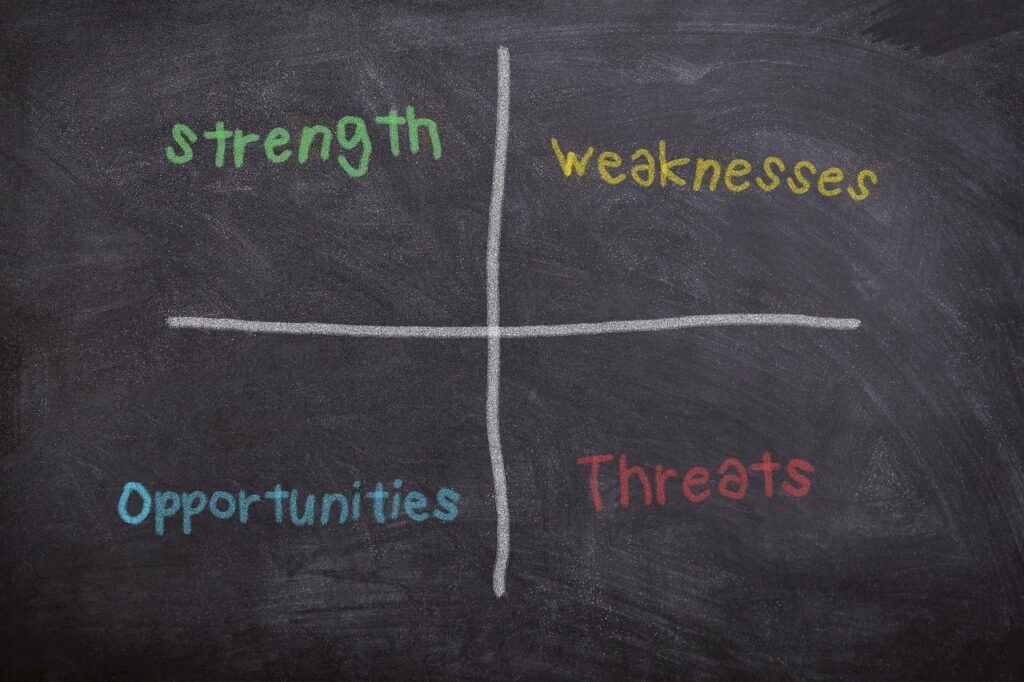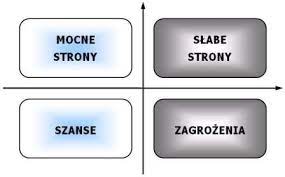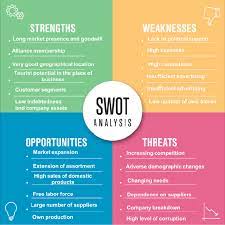PORADNIK DLA MŁODEGO PRZEDSIĘBIORCY
CZĘŚĆ 2:
ANALIZA SWOT
SWOT analysis is one of the basic methods of strategic analysis of a company. The name of the method is an acronym for strengths, weaknesses, opportunities, threats. It can be used for the entire enterprise, or in particular spheres of its operation, eg marketing, finance, production, etc. It can also be used in advisory activities (consulting) as a technique of preliminary strategic analysis of the enterprise (organization) ordering the consulting service.

Origin of SWOT analysis
In the years 1960-1970, a study commissioned by the largest American companies was carried out at the Stanford Research Institute, the purpose of which was to identify ways to improve strategic planning processes and avoid planning errors. The result of these studies was the development of 4 groups of factors determining the effects of planning activities:
good (satisfying) factors in the present Satisfactory,
good (positive) factors in the future – Opportunity,
bad factors in the present – weaknesses,
bad factors in the future – threats.


Steps of preparing the SWOT analysis
A SWOT analysis in a company is usually a multi-person endeavor. It is conducted by an external consultant or by an employee with appropriate qualifications. The basic steps of the analysis include:
- Defining the purpose and subject of the SWOT analysis in the organization, explaining to all involved employees why the analytical activities are undertaken.
- Introducing the analysis procedure to the participants, this step is necessary to ensure a consistent approach to the analysis in the team of participants.
- Development of individual lists of strengths / weaknesses as well as opportunities and threats – each team member first independently draws up a list of all factors considered by him to be important for the strategic position of the company.
- Integration of individual lists, development of a common SWOT matrix, common nomenclature, selection of less important factors.
- Discussion and honest dialogue of all participants involved in the research, looking at the issues from different points of view.
- Development of plans and variants of activities in the future includes the presentation of initial action strategies, which will then be detailed and implemented.
Sometimes it makes sense to take one step back in order to move the power forward at a later stage. We know it is difficult for us to admit our mistakes, but it is necessary for further development. It should be assessed which activities bring us the expected results and which lead our company to the abyss. For this purpose, it is worth considering the statistics collected by us or competitive companies.

It is impossible to be successful without taking some risks. However, it should be checked whether our actions will bring results. For this purpose, it is worth looking at the data and assessing possible opportunities and threats. It is important not to make the same mistakes as the competition.
Opportunities are all changes in the organization’s environment that may have a positive impact on its functioning. These include, for example, an increase in demand, the emergence of a new group of customers, little competition, favorable law, access to advanced technologies, changes in consumer behavior or a good economic situation in the country

Threats, just like opportunities, are factors independent of the enterprise, this time they pose a threat of negative changes. These include all crises, numerous competition, low demand for a given product, unfavorable law, changing trends or the presence of a monopolist on the market.
